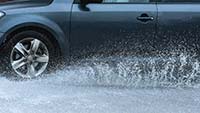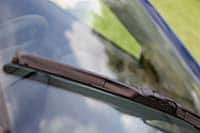Driving In The Rain Safely
 Driving in the rain can be difficult, even for the most experienced drivers. Heavy rain and showers can cause lots of accidents and mishaps, as each driver’s visibility is considerably reduced. Therefore, it’s always important to know some effective road rules and tips to help keep you and other drivers safe during heavy rain periods, whilst also allowing you to control your vehicle better.
Driving in the rain can be difficult, even for the most experienced drivers. Heavy rain and showers can cause lots of accidents and mishaps, as each driver’s visibility is considerably reduced. Therefore, it’s always important to know some effective road rules and tips to help keep you and other drivers safe during heavy rain periods, whilst also allowing you to control your vehicle better.
Drive At Slow Speeds
Speeding in heavy rain is a recipe for disaster, not only will you be risking your safety but also the safety of others around you. Whereas, if you reduce your speed, it can be a great way to keep yourself safe because it will reduce your stopping distance, meaning you won’t be risking a collision with the vehicle in front of you.
Also, driving slower allows you to be more aware of your surroundings. For example, you can avoid or pass through puddles slowly and easily without causing a splash that will hit other cars on the road. By driving at slow and steady speeds, you can prevent ‘aquaplaning’, which is the build-up of water under the tyres. By avoiding this, you will be able to maintain a good amount of traction and your steering ability won’t be affected.
Increase The Distance Between You And The Car In Front
It takes a longer time to stop in wet weather than it does in dry weather, so give yourself plenty of time and room to stop during rain. It’s better to stay a safe distance behind than risk rear-ending the vehicle ahead of you, which is why it is good to adopt the four-second rule to allow a safe stopping distance. When it comes to driving behind lorries and large trucks, you should be wary and take more care, as the spray from them can significantly reduce your visibility.
Ensure You Can See The Road Properly
Bad weather (rain or fog) calls for using dipped headlights, as it will ensure that you are maintaining maximum visibility. It will also ensure that other road users and pedestrians can easily spot you.
Furthermore, ensure that you have heating and air conditioning systems that work effectively, as you’ll need to utilise them to keep your windows from becoming fogged up. It’s harder to see when you are driving with windows that are in need of demisting, so make sure that you maintain and regularly check your heating and cooling system, in order to be prepared for any unexpected, bad weather conditions.
Check Your Tyres
Essentially, your tyres need to be in excellent working condition when it comes to heavy rain. Therefore, it’s important to ensure your vehicle has the correct tyre pressure, to increase traction with the road. Also, you should check your tyre tread depth; the minimum depth of tread for car tyres is 1.6mm across the central three-quarters of the tyre on every wheel. However, many experts argue that to increase the safety of vehicles, the minimum depth should be 3mm.
If your tyres are nearly bald and the grooves are not deep enough to guide the water out from under the tread, this could easily cause an accident, as you could lose control of your vehicle.
Check Your Windshield Wipers
 If your windscreen wipers do not completely clear your windshield with one wipe, then they will need to be replaced. Suppose your windshield wipers are squeaking and skipping across the windshield, this is also a sign that you may need to consider installing a new pair.
If your windscreen wipers do not completely clear your windshield with one wipe, then they will need to be replaced. Suppose your windshield wipers are squeaking and skipping across the windshield, this is also a sign that you may need to consider installing a new pair.
Your wipers should always be in perfect working order, to maintain your visibility in bad weather. You can also regularly clean and maintain them to make sure of this, for example, wiping the wiper blades can help remove any debris or stones that have stuck to them. In the UK, weather can always be very unpredictable, so don’t wait until you get caught with your windscreen wipers not working, give them a quick check whenever you can!
Try Not To Use Cruise Control
Cruise control is best used in dry conditions, rather than in wet weather, so it’s smart to avoid using it in the latter. This is because the risk of losing control of your vehicle is increased significantly. To prevent loss of traction, you may need to reduce your car’s speed by easing your foot off the accelerator rather than braking and this option is not available when your cruise control is on.
Prevent Skidding
The idea is to prevent yourself from skidding in any kind of situation, however, if you do end losing traction, then there are a few things you can do to recover from one and regain control.
- It is important to not panic in this situation and try to remain calm (easier said than done).
- Make sure that you have both hands on the steering wheel and continue to steer and look in the direction you want the front wheels to go in.
- Try to avoid any sudden braking or accelerating, because this will make the skid worse.
- You can ease off the breaks if that was the original cause of the skid, and then gently accelerate to fix it. If you accelerated and that was the cause, ease off the accelerator.
Avoid Deep Puddles
Of course, your first instinct should be to avoid any puddles that look deep, however, if you’re forced to go through one, try to drive on the highest section of the road. After you have driven through the water, remember to drive slowly with your foot on the brakes to dry them off over a short distance. If you cannot see the road because it is submerged in water, then you should find another route to your destination.
Check The Weather In Advance & Plan
The best thing to do to ensure that you have a safe drive, is to check the weather in advance and plan according to what type it will be. For example, if it will be heavy downpours, give yourself more time to complete your journey and avoid isolated areas that may not be looked after. It is always best to avoid long-distance or unnecessary journeys when the weather is poor.
Do not take the risk – plan another day or try to find an alternative mode of travel. If you cannot delay, reschedule or prevent yourself from driving in bad weather conditions, it is worth checking that your insurance policy will cover you if anything occurs.


Great post! Have forwarded this to my family group.
Keep it up!